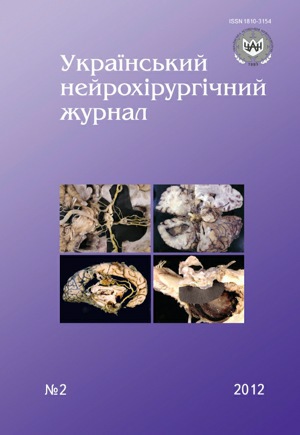Qualitу of life at children with critical hydrocephalus
DOI:
https://doi.org/10.25305/unj.59040Keywords:
critical hydrocephalus, ventriculoperitoneal shunt operations, results of treatment, childrenAbstract
Introduction. In article modern views at a problem of treatment of critical hydrocephalus at children were analysed.
Materials and methods. The purpose of research was to study the results of shunt operations of 96 children with critical hydrocephalus. Age of patients was from three months to two years. Ventriculoperitoneostomy was performed in all children. Histological research of biopsy materials of cerebral tissue were conducted in 10 cases. A catamnesis was followed for 2–17 years.
Results. In 49% cases after operation good (in 19%) or satisfactory (in 30%) quality of patients’ life was achieved. At microscopic research of brain tissue the correlation of destructive changes rate and hydrocephalus severity, caused not only by hypertension, was established.
Conclusions. At critical hydrocephalus changes in brain tissue mostly concern damage of glial cells. Maintenance of considerable part of neurons and glial cells proliferation are important pre-condition for neural cells reparation and cerebral functions renewing. Inflammatory and vascular etiology of hydrocephalus have negative influence.
References
1. Faghih Jouibari M, Baradaran N, Shams Amiri R, Nejat F, El Khashab M. Huge hydrocephalus: definition, management, and complications. Childs Nerv Syst. 2010;27(1):95-100. [PubMed]
2. Zinenko D. [Clinico-pathogenetic characteristic of post-hemorrhagic hydrocephalus, optimize its diagnosis and treatment of premature infants] [dissertation]. Moscow (Russia): Burdenko Neurosurgery Institute; 2010. Russian.
3. Orlov Y, Marushchenko L, Protsenko I. [Results of hydrocephalus surgical treatment caused by perinatal brain injury at children]. Ukrainian Neurosurgical Journal. 2009;(2):75–79.Ukrainian.
4. Orlov Y, Protsenko I, Marushchenko L. Yakist zhyttya ditey z hidrotsefaliyeyu, operovanykh v hrudnomu vitsi [The quality of life of children with hydrocephalus operated in infancy]. Sotsialnaya pediatriya i reabilitolohiya. 2007;1(4):84–89. Ukrainian.
5. Drake J. The surgical management of pediatric hydrocephalus. Neurosurgery. 2008;62(Supplement 2):633-640. [CrossRef] [PubMed]
6. Drake J. The surgical management of pediatric hydrocephalus. Neurosurgery. 2008;62(Supplement 2):633-640. [CrossRef] [PubMed]
7. Orlov Y. [An estimation of quality of life of the patients with defeats of the central nervous system]. Ukrainian Neurosurgical Journal. 2001;(1):89–94. Russian. [Abstract/Full Text]
8. Chazal J. Management of hydrocephalus in childhood. In: Practical Handbook of Neurosurgery. Springer Vienna, 2009. p.1025-1041.
9. Sgouros S, Kulkharni A, Constantini S. The international infant hydrocephalus study: concept and rational. Childs Nerv Syst. 2006;22(4):338-345. [CrossRef] [PubMed]
10. Rosin Y. Dopplerografiya Sosudov Golovnogo Mozga U Detey [Doppler Blood Vessels Of The Brain In Childrens]. St. Peterburg: Izdatel'skii dom SPbMAPO; 2006. Russian.
11. Kharchenko L, Protsenko I, Malovichko I. Narusheniya mozgovogo krovoobrashcheniya u novorozhdennykh kak prichina razvitiya gidrotsefalii (analiticheskiy obzor) [Cerebrovascular accident in infants as a cause of hydrocephalus (Analytical Review)]. Neyrokhirurgiya i nevrologiya detskogo vozrasta. 2008;(1-2):116–122. Russian.
12. Kulkarni A. Quality of life in childhood hydrocephalus: a review. Childs Nerv Syst. 2010;26(6):737-743. [CrossRef] [PubMed]
13. Owens R. Intraventricular Hemorrhage in the Premature Neonate. Neonatal Network: The Journal of Neonatal Nursing. 2005;24(3):55-71. [CrossRef] [PubMed]
14. Futagi Y, Suzuki Y, Toribe Y, Nakano H, Morimoto K. Neurodevelopmental Outcome in Children With Posthemorrhagic Hydrocephalus. Pediatric Neurology. 2005;33(1):26-32. [CrossRef] [PubMed]
Downloads
Published
How to Cite
Issue
Section
License
Copyright (c) 2012 Yuriy Orlov, Igor Malovichko, Leonid Marushchenko, Anna Shmeleva

This work is licensed under a Creative Commons Attribution 4.0 International License.
Ukrainian Neurosurgical Journal abides by the CREATIVE COMMONS copyright rights and permissions for open access journals.
Authors, who are published in this Journal, agree to the following conditions:
1. The authors reserve the right to authorship of the work and pass the first publication right of this work to the Journal under the terms of Creative Commons Attribution License, which allows others to freely distribute the published research with the obligatory reference to the authors of the original work and the first publication of the work in this Journal.
2. The authors have the right to conclude separate supplement agreements that relate to non-exclusive work distribution in the form of which it has been published by the Journal (for example, to upload the work to the online storage of the Journal or publish it as part of a monograph), provided that the reference to the first publication of the work in this Journal is included.









